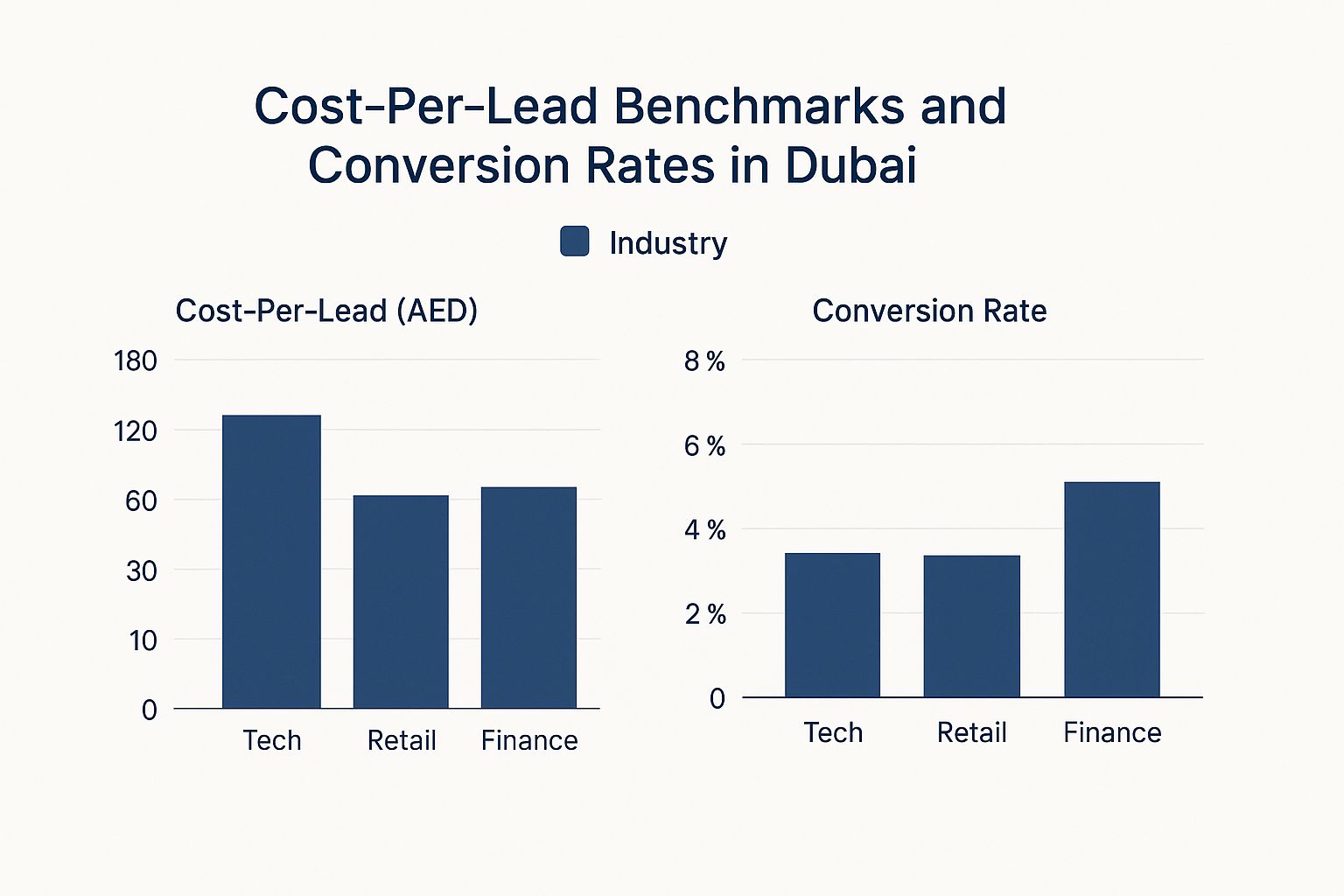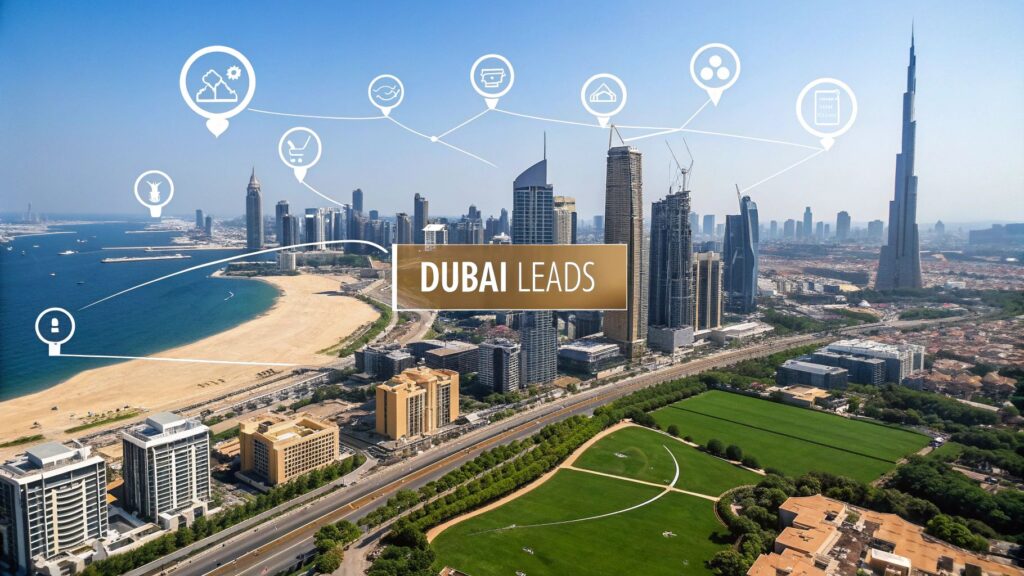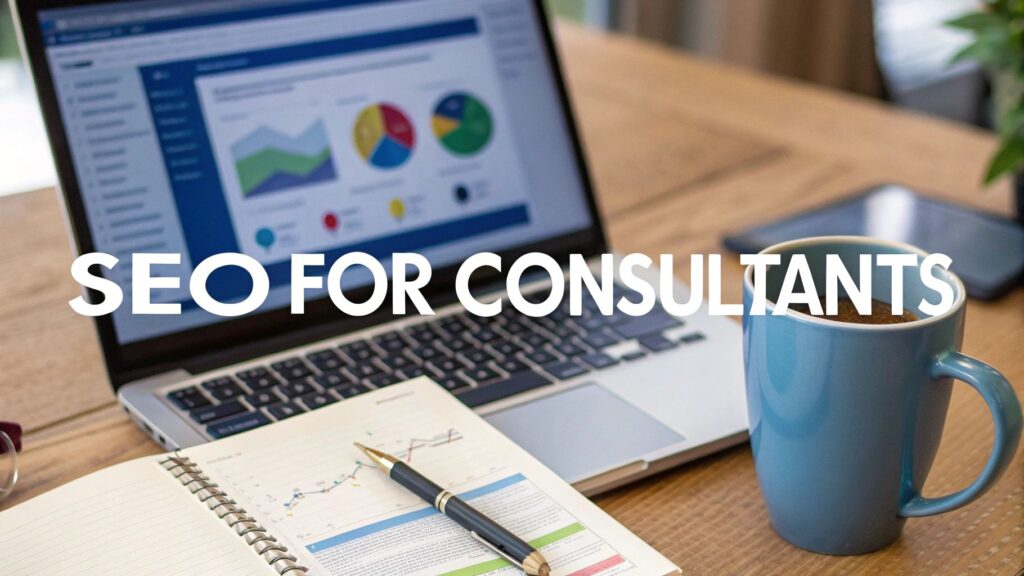If you’re serious about growing your business in Dubai, you can’t afford to treat lead generation as an afterthought. Finding the right partner to keep your sales pipeline full isn’t just helpful—it’s a fundamental requirement for survival in this fiercely competitive market. This is about more than just outsourcing a task; it’s about building a consistent, reliable engine for growth.
Why You Need a Specialist Lead Generation Partner in Dubai

Dubai’s business environment is a different beast altogether. It’s a global hub where opportunities can materialise in an instant, but so can new competitors. Trying to manage lead generation entirely in-house often stretches your team too thin, leading to inconsistent results and, frankly, missed opportunities.
This is where a dedicated lead generation company in Dubai comes in. They bring a level of focus, sophisticated tools, and deep market knowledge that most internal teams just can’t match.
We’re not just talking about generating a high volume of contacts. It’s about finding an agency that truly gets the local culture, the unwritten rules of business etiquette, and the unique purchasing behaviours across the MENA region. A strategy that works wonders in London or New York will almost certainly fall flat here.
The Challenge of Getting Noticed
The sheer number of new businesses launching in Dubai means everyone is fighting for the same customer attention. This has made the lead generation industry an essential part of the Emirate’s economic engine.
Think about it: with over 4,000 new businesses established monthly in Dubai, the demand for qualified leads is relentless. This intense competition has pushed top firms to adopt highly advanced, data-driven marketing strategies to generate quality leads that actually convert.
In an environment this crowded, a specialist partner becomes your secret weapon. They know how to cut through the noise and connect with prospects who have a real, immediate need for what you offer.
The Real Advantages of a Specialised Agency
A local partner gives you far more than just a list of names; they provide a genuine strategic edge. Their grasp of the market ensures your messaging hits the mark, saving you an incredible amount of time and wasted budget.
Here’s what you actually gain by partnering with a local expert:
- Deep Market Knowledge: They live and breathe the local nuances—from regulatory hurdles to the cultural subtleties that sway purchasing decisions.
- Access to Better Tools: The best agencies have already invested in premium marketing automation, analytics, and data platforms that would be far too expensive for most individual businesses.
- Growth on Your Terms: As you expand, a good agency can scale its efforts up or down instantly. You get the flexibility without the overhead of hiring and training new staff.
- A Clear ROI: These agencies operate on performance. They provide straightforward reports on cost-per-lead, conversion rates, and the bottom-line return on your investment.
A great lead generation partner doesn’t just deliver leads; they deliver opportunities. They become a true extension of your sales team, obsessed with filling your pipeline with prospects who are genuinely ready to talk business.
Ultimately, picking the right lead generation company in Dubai is one of the most important strategic decisions you’ll make. It frees up your team to do what they do best—close deals and delight customers—while ensuring a steady stream of new opportunities is always coming through the door.
Setting Goals That Actually Drive Revenue
Before you even think about shortlisting a lead generation company in Dubai, you need to look inward. The most common mistake I see is businesses rushing into conversations with a vague request like “we need more leads.” That’s a surefire way to burn through your budget with little to show for it.
Success starts with defining exactly what a “win” looks like for your business. This means moving beyond simple volume and getting granular about quality, cost, and, most importantly, revenue. Without this groundwork, you have no real way to measure if your investment is paying off.
First Things First: Define Your Ideal Lead
Let’s get one thing straight: a list of 1,000 random contacts is junk. A list of 10 genuinely interested, well-matched prospects is gold. The crucial first step is to stop asking “how many leads?” and start asking “what kind of lead?”
This is where you need to build a rock-solid definition of a Sales Qualified Lead (SQL). Don’t do this in a silo. Sit down with your sales team—they’re the ones on the front line who will ultimately decide if the leads are any good. A strong SQL definition is your filter, ensuring the agency only sends opportunities with a real shot at closing.
Get specific. A good SQL profile should include:
- Firmographics: Are you targeting a specific industry, company size, or annual revenue bracket within the UAE?
- Demographics: Who is the decision-maker? Pinpoint the exact job titles, like ‘CFO’ or ‘Head of IT’.
- Buying Intent: What actions signal they’re ready for a conversation? Maybe they requested a demo, downloaded a case study, or spent time on your pricing page.
- Budget Authority: Can this person sign the cheque, or are they an influencer who needs to convince someone else?
A clearly defined SQL is the bedrock of your agreement with a lead generation partner. It aligns everyone on what a quality opportunity looks like, cutting out the guesswork and making your sales process far more efficient from day one.
Establish Your Key Performance Indicators
Once you know who you’re looking for, you need to decide how you’ll measure success. Clicks and impressions are nice, but they don’t pay the bills. You need to hold your chosen lead generation company in Dubai accountable for metrics that are directly tied to your bottom line.
Focus on the KPIs that truly matter:
- Cost Per Lead (CPL): How much are you paying to acquire one lead? Be realistic; the Dubai market is competitive.
- SQL to Customer Conversion Rate: What percentage of qualified leads actually become paying customers? This is the ultimate test of lead quality.
- Customer Lifetime Value (CLV): What’s the total revenue you can expect from a customer over time? A high CLV can justify a higher CPL.
- Sales Cycle Length: How long does it take to turn a lead into a closed deal? A great agency should deliver prospects who are further along the buying journey, shortening this cycle.
As you can see below, what’s considered a “good” CPL or conversion rate varies wildly depending on your industry.

This just goes to show why setting industry-specific goals is so critical. You can’t rely on generic benchmarks.
Tie Everything Back to Revenue
Here’s where it all comes together. Connect these KPIs directly to your company’s big-picture financial targets. It’s a simple but powerful exercise.
Let’s say your quarterly revenue goal is an additional AED 200,000. If your average deal is worth AED 20,000, you know you need to close 10 new deals. Simple, right?
Now, work backwards. If your historical SQL-to-customer conversion rate is 20% (or 1 in 5), you’ll need 50 sales-qualified leads this quarter to hit that revenue target.
Suddenly, “we need more leads” has become a clear, actionable objective: “we need 50 SQLs that fit our defined profile to generate AED 200,000 in new business.” When you walk into a meeting with a prospective agency armed with that level of clarity, they know you’re serious. More importantly, it gives them a precise target to build their entire strategy around.
Matching Agency Services to Your Business Needs

When you’re vetting a lead generation company in Dubai, it’s easy to get dazzled by a long menu of services. But the goal isn’t to find an agency that does everything; it’s to find the one that excels at the right things for your business.
A strategy that works wonders for a B2C e-commerce brand selling to tourists in Dubai Mall will likely fall flat for a B2B software firm targeting enterprise clients in JLT. It all comes down to aligning the agency’s core strengths with your go-to-market strategy.
The first, most crucial distinction to understand is the difference between inbound and outbound lead generation.
Inbound vs. Outbound: A Quick Primer
Think of it this way: are you a magnet or a megaphone?
Inbound marketing is the magnet. It’s all about pulling customers in by creating valuable content and experiences they actively seek out. They find you through search engines, blogs, and social media because you’re offering answers to their problems.
Outbound marketing is the megaphone. This is a more direct approach where you proactively push your message out to a targeted audience. Classic examples include cold calling or highly specific email campaigns where you initiate the conversation.
Neither is universally better. In fact, the most sophisticated campaigns often blend the two. But knowing where to focus your budget is key.
Aligning Inbound Strategies With Your Business
Inbound is the long game. It’s about building brand authority and creating a pipeline of leads who are already interested because they found you.
This approach is incredibly effective for businesses with longer sales cycles or complex services that require customer education. A B2B consultancy in DIFC, for instance, would gain huge traction by publishing insightful whitepapers on new financial regulations. CFOs actively searching for that information will find the firm, already viewing them as an expert.
Common inbound services an agency should excel at include:
- Search Engine Optimisation (SEO): This is non-negotiable. Ranking for the keywords your customers are searching for captures high-intent traffic day in and day out. A solid approach to SEO is the bedrock of any serious long-term lead generation effort.
- Content Marketing: Creating and distributing genuinely useful content—think blog posts, detailed case studies, or market reports—that attracts and engages your ideal customer.
- Social Media Marketing: Building a genuine community on platforms like LinkedIn or Instagram, sharing relevant content that draws in followers who fit your ideal customer profile.
The real magic of inbound is that you’re creating assets. A great blog post or a comprehensive guide can continue to generate leads for years, delivering a fantastic long-term return on your initial investment.
When Outbound Makes More Sense
Sometimes, you simply can’t wait for the phone to ring. Outbound is all about speed and precision, letting you target a hand-picked list of potential buyers directly.
This is the perfect method for companies with a very specific, easily identifiable audience. Imagine a firm that sells specialised cooling systems to a handful of major data centres in the UAE. Instead of writing broad blog posts, it’s far more efficient to contact the facility managers at those specific locations.
Key outbound services to look for:
- Targeted Email Outreach: Crafting personalised, relevant email sequences to key individuals within your target accounts.
- LinkedIn Prospecting: Using tools like LinkedIn Sales Navigator to pinpoint and connect with decision-makers.
- B2B Database Sourcing: Accessing high-quality, compliant data to build hyper-targeted lists for outreach campaigns.
To help you visualise where different strategies fit, here’s a quick comparison of common channels in the Dubai market.
Comparing Lead Generation Strategies for the Dubai Market
| Strategy | Best For | Key Metric | Dubai-Specific Consideration |
|---|---|---|---|
| SEO | Long-term, sustainable growth; businesses with search demand. | Organic Traffic, Keyword Rankings, MQLs | High competition in sectors like real estate and tourism requires niche keyword targeting. |
| PPC (Google Ads) | Immediate lead flow; testing offers and landing pages. | Cost Per Lead (CPL), Conversion Rate | Bidding wars for high-value keywords are common; a high budget or very specific niche is needed. |
| Content Marketing | Building authority and trust; complex B2B sales cycles. | Asset Downloads, Time on Page, Inbound Links | Content must be culturally relevant and often multilingual (English/Arabic) to resonate. |
| LinkedIn Outreach | B2B companies with a clearly defined decision-maker. | Connection Rate, Reply Rate, Meetings Booked | Personalisation is crucial to cut through the noise, as many decision-makers receive high volumes of outreach. |
| Email Marketing | Nurturing existing leads; direct outreach to cold lists. | Open Rate, Click-Through Rate, Unsubscribe Rate | Adherence to local data privacy laws (e.g., PDPL) is essential to avoid penalties. |
This table provides a starting point, but the best approach often isn’t an “either/or” choice.
The Hybrid Approach: Getting the Best of Both Worlds
For many businesses in Dubai, the most powerful strategy is a hybrid one. You can use outbound to create immediate opportunities while your inbound engine works in the background, nurturing leads and cementing your brand’s reputation.
For example, a luxury real estate agency might run a targeted LinkedIn ad campaign (outbound) to high-net-worth individuals. That ad could direct them to a beautifully designed landing page with a downloadable guide to investing in Dubai property (inbound).
The ad gets their attention now, and the valuable content builds the trust needed for them to take the next step. This combination delivers both immediate results and sustainable, long-term growth.
Getting the Price and Paperwork Right
Let’s talk money and contracts. This is where a promising partnership can either solidify or fall apart. When you’re looking at lead generation companies in Dubai, you’ll find a few common ways they structure their fees. Getting your head around these models is the key to finding a deal that fits your budget and, just as importantly, your appetite for risk.
The goal here isn’t just to find the cheapest option. It’s about finding a structure that makes sense for your business, where the agency’s success is directly tied to yours.
The Standard Monthly Retainer
This is the old-school, tried-and-true model. You pay a set fee every month, and the agency gets to work on an agreed-upon plan. This might cover everything from running outreach campaigns to creating content and tweaking the strategy as they go.
- The upside? Your costs are completely predictable. You know exactly what’s coming out of your marketing budget each month, which makes life easy for your finance team.
- The downside? All the risk is on you. If they have a slow month and don’t deliver many leads, you still pay the full amount.
A retainer makes sense if you see lead generation as a long-term strategic play, not just a tap you turn on and off. It’s for businesses that have found a partner they trust to put in consistent, quality work over time.
Performance-Based Pricing: Paying for What You Get
The Dubai market has really embraced performance-based models, and for good reason. The most common flavour you’ll see is Pay-Per-Lead (PPL). It’s simple: you pay a fixed price for every qualified lead they hand over. This approach takes a lot of the guesswork and risk out of the equation.
- The upside? Your financial risk is incredibly low. No leads? No invoice. It forces the agency to focus on delivering tangible results.
- The downside? The cost for each lead might seem higher. The agency has to price in their own risk, so they’ll charge a premium for the guarantee.
This is a brilliant model for companies that need to justify every dirham of marketing spend or for those dipping their toes into a new market.
Hybrid Models: The Best of Both Worlds
A lot of the smarter agencies in Dubai are now offering a hybrid approach. This usually looks like a small base retainer—just enough to cover their core operational costs and strategic planning—plus a performance bonus.
Think of it this way: you might pay a modest monthly fee, and then an extra payment for every lead that books a meeting with your sales team. This creates a genuine partnership. Both of you are gunning for the same thing: actual revenue.
This shared-risk model is often the sweet spot. It ensures the agency has the stability to think long-term while keeping them laser-focused on the bottom-line results that really move the needle for you.
Don’t Skim the Contract
No matter which pricing model you choose, the contract is everything. This is not the time to skim. Before you even think about signing, you need to go through the agreement with a fine-tooth comb and get crystal-clear answers on a few critical points.
Here’s your checklist for the fine print:
- What Exactly is a “Lead”? The contract must spell out the precise definition of a qualified lead that you agreed on earlier. No ambiguity allowed.
- Who Owns the Data? You do. End of story. The contract should state that you have full ownership of all contact lists and campaign assets.
- How Will You Track Progress? What gets measured gets managed. The contract should specify reporting frequency and, ideally, give you access to a live dashboard.
- What’s the Exit Strategy? How do you part ways if things don’t work out? Look for a fair notice period, like 30 days, without any nasty financial penalties.
- Are They Working With Your Rivals? An exclusivity clause can be a huge win, preventing the agency from taking everything they learn from you and using it to help your direct competitors in Dubai.
Getting these details hammered out from the get-go is the difference between a partnership built on trust and one that’s doomed to fail from misunderstandings.
How Technology and Creativity Win Leads

In a market as fierce as Dubai’s, winning at lead generation is a delicate balancing act. It’s about merging the precision of data and technology with the magnetic pull of great creative. Having the latest marketing software isn’t enough. Neither is a stunning ad campaign on its own. The real results, the ones that move the needle, happen when both sides work in perfect harmony.
Any top-tier lead generation company in Dubai worth its salt knows this isn’t an “either/or” situation. You have to be brilliant at both. Technology tells you who to target and when to reach them, while creativity delivers the compelling what and why that makes someone actually take action. If one half of that equation is weak, you’re just pouring your ad budget down the drain.
The Power of a Smart Tech Stack
Think of technology as the engine powering your entire lead generation machine. It automates the grunt work, offers incredible insights into what your prospects are thinking, and allows for a level of personalisation that was pure science fiction just a decade ago. This is where you can really tell the pros from the amateurs.
A truly competent agency will have a powerful toolkit at its disposal, likely including:
- Marketing Automation Platforms: These are the workhorses that manage everything from complex email sequences to scoring leads, making sure no potential customer ever falls through the cracks.
- Customer Relationship Management (CRM) Tools: A solid CRM is the brain of the operation. It tracks every single touchpoint, giving your marketing and sales teams a unified view of the customer journey.
- Advanced Analytics and AI: The best firms are using AI to crunch campaign data in real-time. They can spot patterns and tweak targeting on the fly, squeezing every last drop of performance out of your budget.
These tools are not just bells and whistles; they’re essential for running precise and scalable campaigns. For example, by using AI-driven lead scoring, an agency can automatically flag the prospects showing the strongest intent to buy. This allows your sales team to stop chasing cold leads and focus their energy where it matters most. It’s worth getting to grips with the mechanics behind this, and understanding what search engine marketing truly entails is a great starting point.
The real point of technology in lead generation isn’t just to be more efficient. It’s to be more intelligent. It’s about turning a sea of data into clear, actionable insights that drive smarter business decisions.
Why Creativity is Your Competitive Edge
So, technology gets your message in front of the right person at the right time. But it’s creativity that makes them stop, look, and listen.
In a visually saturated market like Dubai, generic copy and tired stock photos are the kiss of death for any campaign. Your first impression is everything. That’s why knockout design and authentic branding are non-negotiable. The way your landing pages, ads, and emails look and feel must build instant trust and communicate professionalism. It’s a core part of what defines modern lead generation in this region.
Your creative assets need to nail three things, every single time:
- Grab Attention: You have seconds to cut through the noise. Bold visuals and a headline that hits on a real pain point are essential.
- Build Credibility: Polished design and clear, consistent messaging tell a prospect you’re a serious, trustworthy business.
- Drive Action: Every single creative element should have a purpose, guiding the user smoothly toward the next step, whether that’s filling out a form or booking a demo.
When you’re vetting a potential lead generation company in Dubai, don’t just ask about their software licenses. Ask to see their work. Dig into their portfolio. Put yourself in the customer’s shoes and ask a simple question: would this campaign make me want to convert? If the answer is no, keep looking.
Making the Right Choice and Kicking Things Off
You’ve done the hard yards—you’ve vetted the proposals, sat through the pitches, and now you’re close to making a decision. Choosing the right lead generation company in Dubai feels like the finish line, but it’s really just the beginning. The real work starts with a solid onboarding process, which is the secret to turning a new vendor into a genuine growth partner.
This last stage is all about being thorough. It’s where you double-check everything, ensure the team dynamic feels right, and build the foundation for a transparent, results-driven relationship right from the get-go.
Making the Final Call with Confidence
Before you sign on the dotted line, it’s time for a final round of due diligence. The glossy case studies and impressive pitch decks are one thing, but you need to hear from the people who have actually worked with them.
When you’re checking references, don’t just ask, “Were you happy with them?” That’s a softball question. You need to dig deeper to understand how they operate under pressure.
Try asking more specific, probing questions like:
- “What was their communication like day-to-day? Were they proactive?”
- “Tell me about a time a campaign wasn’t working. How did they handle it?”
- “How often did you hear from their senior people after the initial launch?”
The answers you get here are pure gold. You’re listening for signs of accountability and a real partnership mindset, not just a vendor who ticks boxes and sends a monthly report.
How an agency handles your final, nitpicky questions is a huge tell. If they’re patient and open, that’s a great sign. If they get defensive or rush you, that’s a glimpse into what the relationship will be like down the road.
Nailing the Onboarding for a Strong Start
Once you’ve made your choice, the first 30 days are absolutely critical. A seamless kickoff sets the tone for everything that follows. The objective is to get from contract signing to campaign launch without any friction, ensuring everyone is on the same page.
While this should be a joint effort, make sure your onboarding checklist covers these key areas:
-
Lock in Roles and Communication Rhythms: Who is your main point of contact? Who is theirs? Sort this out immediately. Set up a shared Slack or Teams channel for quick questions and establish a standing weekly or bi-weekly call to review progress.
-
Demand a Shared Performance Dashboard: This is a non-negotiable. You need real-time, transparent access to the data. At any moment, you should be able to see core metrics like leads generated, cost-per-lead, and conversion rates. Many agencies excel at this, and if paid media is part of the plan, a specialised PPC advertising firm can set up tracking that leaves no room for error.
-
Build a 90-Day Roadmap Together: The best partnerships start with a shared vision. Work with your new agency to map out concrete goals, key activities, and what success looks like for the first quarter. This keeps everyone aligned and gives you a clear benchmark for evaluating their early performance.
A structured onboarding process gets rid of the guesswork and avoids that frustratingly slow start that so often happens with new agencies. It gives your new partner everything they need to hit the ground running and start delivering a return on your investment right away.
Got Questions? We’ve Got Answers
When you’re looking to partner with a lead generation agency in Dubai, a few key questions always come up. Here are some straight-talking answers based on what we see in the market every day.
What’s the Real Cost of Lead Generation in Dubai?
This is the big one, and the honest answer is: it varies wildly. For a comprehensive campaign managed on a monthly retainer, you could be looking at anything from AED 10,000 to over AED 50,000. The final figure really depends on how aggressive you want to be and the channels involved.
Another popular route is the pay-per-lead (PPL) model. Here, you’re buying outcomes directly. A simple B2C lead might cost around AED 50, whereas a highly-vetted B2B prospect who has already agreed to a meeting could run into several hundred dirhams. My advice? Don’t just hunt for the cheapest price; focus on the potential return and the quality of the lead.
How Quickly Can I Expect to See Results?
Patience is a virtue, but in business, speed matters. If you’re using paid advertising like Google Ads or laser-focused social media campaigns, you can start seeing leads trickle in within the first month. These channels are designed for near-instant impact.
Organic strategies, on the other hand, are a different game altogether. Think of SEO and content marketing as building a valuable asset. It takes time to gain traction and authority, so you should realistically budget four to six months before you see a steady flow of high-quality inbound enquiries. A good agency will be upfront about this and set clear milestones along the way.
How Do I Make Sure the Leads Are Actually Good?
Lead quality isn’t about luck; it’s about alignment. The single most important thing you can do is work with your agency to create a rock-solid definition of a ‘qualified lead’. Get specific. What industry are they in? What’s the company size? What’s the job title of the person you need to speak to? Write it all down.
The secret to maintaining quality over time is simple: talk. Set up a regular feedback session with your agency to review the leads. This constant communication allows them to tweak their targeting on the fly, ensuring what they deliver is exactly what your sales team needs to close deals.
At Invocom, we don’t just generate leads; we build the digital engines that drive real, sustainable growth. Whether it’s integrating your CRM for a seamless workflow or launching targeted SEO and SEM campaigns, we deliver end-to-end solutions that turn business goals into tangible results.
See how our strategic approach can fill your sales pipeline. Find out more at https://invocom.me.





